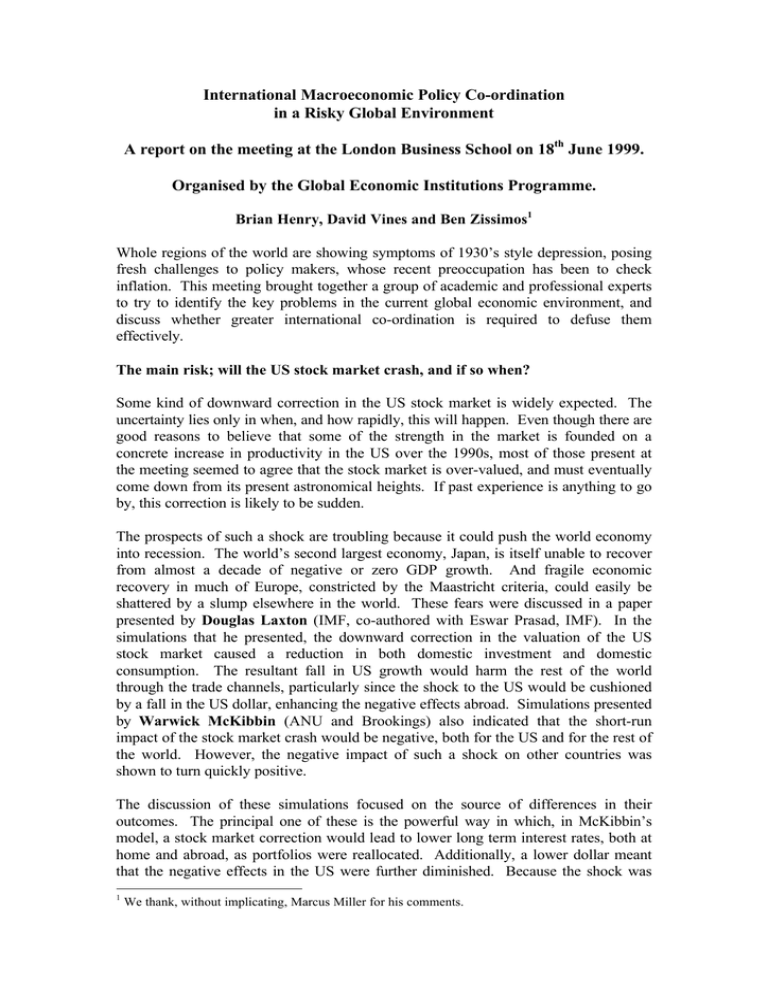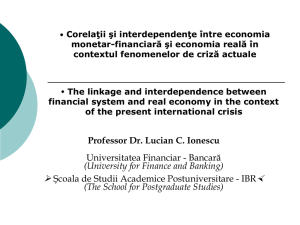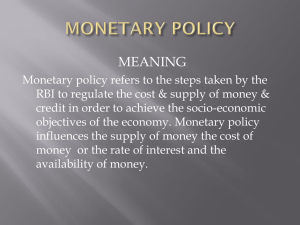International Macroeconomic Policy Co-ordination in a Risky Global Environment
advertisement

International Macroeconomic Policy Co-ordination in a Risky Global Environment A report on the meeting at the London Business School on 18th June 1999. Organised by the Global Economic Institutions Programme. Brian Henry, David Vines and Ben Zissimos1 Whole regions of the world are showing symptoms of 1930’s style depression, posing fresh challenges to policy makers, whose recent preoccupation has been to check inflation. This meeting brought together a group of academic and professional experts to try to identify the key problems in the current global economic environment, and discuss whether greater international co-ordination is required to defuse them effectively. The main risk; will the US stock market crash, and if so when? Some kind of downward correction in the US stock market is widely expected. The uncertainty lies only in when, and how rapidly, this will happen. Even though there are good reasons to believe that some of the strength in the market is founded on a concrete increase in productivity in the US over the 1990s, most of those present at the meeting seemed to agree that the stock market is over-valued, and must eventually come down from its present astronomical heights. If past experience is anything to go by, this correction is likely to be sudden. The prospects of such a shock are troubling because it could push the world economy into recession. The world’s second largest economy, Japan, is itself unable to recover from almost a decade of negative or zero GDP growth. And fragile economic recovery in much of Europe, constricted by the Maastricht criteria, could easily be shattered by a slump elsewhere in the world. These fears were discussed in a paper presented by Douglas Laxton (IMF, co-authored with Eswar Prasad, IMF). In the simulations that he presented, the downward correction in the valuation of the US stock market caused a reduction in both domestic investment and domestic consumption. The resultant fall in US growth would harm the rest of the world through the trade channels, particularly since the shock to the US would be cushioned by a fall in the US dollar, enhancing the negative effects abroad. Simulations presented by Warwick McKibbin (ANU and Brookings) also indicated that the short-run impact of the stock market crash would be negative, both for the US and for the rest of the world. However, the negative impact of such a shock on other countries was shown to turn quickly positive. The discussion of these simulations focused on the source of differences in their outcomes. The principal one of these is the powerful way in which, in McKibbin’s model, a stock market correction would lead to lower long term interest rates, both at home and abroad, as portfolios were reallocated. Additionally, a lower dollar meant that the negative effects in the US were further diminished. Because the shock was 1 We thank, without implicating, Marcus Miller for his comments. modelled as being specific to the US market, it is easy to see that abroad the monetary easing effects could dominate the negative transmission through trade, and this is what happens in McKibbin’s model. McKibbin defended these results strongly, pointing out that he had correctly predicted that the Asia crisis would be good for growth in the US because of the disinflationary effects, and subsequent monetary easing, which came in its wake. Of some concern was whether a stock-market correction could plausibly modelled as being confined to the US. The shock itself was effected by raising the risk premium on US bonds and equities, causing capital to shift to the rest of the world, promoting growth there. However, Simon Wren-Lewis (Exeter University) made the point that a US stock market crash would probably precipitate stock market crashes elsewhere, with direct deleterious impact on domestic economic activity in the countries where this happened. One aim of the Laxton and Prasad paper was to draw attention to the consequences of Japan’s current deflationary predicament, first referred to in the 1930s by Keynes as a liquidity trap2. Because Japan’s nominal short-term interest rate is already close to zero, this curtails the use of monetary policy to offset a negative international demand shock, significantly increasing its deflationary impact. This point was emphasised by re-running the US stock market crash simulation under the assumption that growth was at its long run trend rate, reflected by higher nominal interest rates. As a result, there was scope to drop Japanese interest rates in response to a stock market crash in the US. The negative impact was much less severe, being halved in Japan and down by a quarter in Europe. Significantly, the effects were more than halved in the US, because of the increased absorption of the shock in Japan. International coordination could help to spring Japan’s liquidity trap Even in the absence of any financial market turmoil, Japan appears to be caught in a liquidity trap. Ronald McKinnon (Stanford University; currently visiting the Bank of England) presented a paper which argues that at least part of Japan’s predicament was imposed from abroad. In particular, since the Bretton Woods “dollar standard” ended in the early 1970s, the US government has put Japanese policy makers under considerable pressure to appreciate the yen against the US dollar. This pressure, McKinnon argued, was mistakenly motivated by a desire to reduce Japan’s trade surplus with the US. Consequently, the expectation has become entrenched that the yen will continue to appreciate. As a result, interest rates on Japanese short-term bonds has historically been about four percentage points below the US equivalent. While through the 1970s and `80s US interest rates were relatively high, this disparity in bond rates did not cause a problem. Now that US bond rates have fallen to historically low levels, the return on Japanese bonds has been pushed towards zero. In the absence of a liquidity trap Japan could use a monetary expansion to help end its recession. An increased quantity of yen in circulation could be used to buy US dollars. 2 Krugman discusses the problem of the liquidity trap with reference to Japan; see “It’ Back: Japan’s Slump and the Return of the Liquidity Trap” Brookings Papers on Economic Activity, 2:1998: 137203. But in a liquidity trap the public refuses to hold more yen, because the monetary base is expected to contract in the future; reflected in an expected yen appreciation. One way to spring a liquidity trap, originally proposed by Keynes, is to use fiscal means to stimulate the economy. And yet this option appears not to be open to the Japanese either. Several government spending initiatives over the 1990s, designed to pump-prime the economy, have done little to lift it out of recession. This may be because of the demographic problems that Japan is currently facing. An ageing population, already conscious of its growing future liabilities as government debt approaches 100% of GDP, is inclined to save more, not less, by further government spending. McKinnon proposed that the best way to resolve this problem would involve explicit policy co-ordination between US and Japanese policy makers. One possibility would be to announce an accord, which would effectively peg the yen to the US dollar at its current exchange rate, breaking the expectation of an ever appreciating yen. This is equivalent to reversing the expectation of future deflation, so that the public will be willing to accept an expansion in the monetary base. The suggestion that Japan’s problems were not all domestically created found favour at the meeting, and it was agreed that a return to stability between the US and Japanese currencies could facilitate monetary expansion in Japan. However, not everyone was convinced by the idea that the yen’s appreciation was primarily motivated by mercantilism on the part of the US government. Jim Rollo (Sussex University ) argued that the yen’s appreciation would partly have stemmed from faster Japanese productivity growth in tradables than in the US. On this basis, the expectation of a future appreciation of the yen is reasonable, given the belief that productivity growth will at some stage in the future resume a faster pace in Japan than in the US? McKinnon responded that, whatever the preferred explanation for it, yen appreciation implies interest rates in Japan that are significantly below those in the US, which may not be viable in the future if US interest rates were themselves to fall close to zero. Restoring a fixed peg thus offers a basis for conducting monetary policy with interest rates roughly on a par between the two countries. European policy coordination; intra- and inter-continental Why, in general, might international policy coordination be needed? If markets functioned perfectly, it is difficult to think of a reason. Andre Sapir (European Commission DG12) drew attention to two types of situation where such a need has been identified in the debate on policy setting within the European Union (EU). The first is motivated by market failure. One example he used was when there are significant spillovers to joint action, as might be the case when a group of central banks jointly defend a currency that is being attacked. Another is where there are institutional rigidities, for example in the labour market. If wages do not fully adjust to a domestic shock then its effects may be transferred to other countries. It may then be better for the countries affected by the shock to offset its impact by some joint fiscal means. Where such market failure is perceived to be permanent, there is likely to be an ongoing need for policy coordination. The second situation where policy coordination might be helpful, dubbed the French perspective, is where one country is significantly constrained in its policy options. Sapir used the example of Spain, which is currently unable to use fiscal policy to stimulate its economy out of recession without violating the Maastricht criteria on the size of its budget deficit. The suggestion is that transfers would be possible from countries with a surplus. This second motivation is transitory, applying to a particular combination of macro-economic circumstances or shocks. Laxton suggested that non-linearities potentially create a third motivation for intervention as the cost (in terms of a social welfare function) of deviations from equilibrium increase non-linearly with the size of a shock. Fiscal transfers are seen as contentious. Perhaps the biggest worry is that they create moral hazard; governments have less incentive to be fiscally responsible if they will be bailed out by others. Indeed, Rollo said that German officials are extremely unhappy at the prospect that Italy might not maintain the Euro-area’s target debt-to-GDP ratio of 3%. And this was without any suggestion that Germany might be asked to step into the breach. Marcus Miller (University of Warwick) pointed out that attempts to rule out moral hazard among fiscal authorities in the Euro area through the imposition of “fiscal rectitude”, is proving very costly. Governments are effectively being prevented from using bond markets to insure against economic uncertainty. While a lot of attention has been devoted to policy coordination within the EU, less thought has been given to the possibility of coordination between the EU and the rest of the world. Sapir suggested that international spillovers, which could motivate an ongoing benefit to policy coordination, are not large enough to make it worth while. However, because the recent financial crisis in the far east prompted fears of a world recession, the US Federal Reserve Bank (Fed) called for the European Central Bank (ECB) to engage in coordinated easing of monetary policy. Moreover, David Vines (Balliol College, Oxford) suggested that a stock market crash in the US could create a much more urgent need for coordination, at least in the short-term. Drawing parallels with Japan’s present difficulties, it was pointed out that the Euro area, also with low growth and interest rates, could similarly find itself unable to use monetary policy to offset a shock. Methodological Issues in Modelling International Policy Coordination To study international policy coordination in detail is difficult because the problem combines two sets of problem solving techniques which are individually complex. First, a key element in contemporary macro-economic policy discussions is the use of large scale models to see how a new policy proposal or rule would work in a realistic environment. This step usually follows a theoretical discussion in the literature, using much simpler analytical models. A complication is that for model simulations that are consistent with the assumption of rational expectations, large scale model solutions must be obtained in which private agents, and possibly economic policy as well, are forward looking. Second, co-ordination between policy makers in different countries raises questions about strategic behaviour. Does a policy making authority - a government or central bank - do best for its nation by acting unilaterally, or by co-ordinating with others? Whatever the answer to this question, it must optimise its policy setting behaviour subject to the choices of policy makers in other countries. This is in itself a complex exercise, even within the context of a fairly simple model, and outcomes will vary with the conjectures made about the responses of other players. Ray Barrell (National Institute, in a paper with Karen Dury and Ian Hurst) proposed to model monetary policy cooperation by introducing a cooperative element to the individual reaction functions of central banks in the National Institute’s large scale macro-econometric model, by abstracting from many of these problems. The focus of this exercise was to examine the effects of explicit monetary policy coordination between the Fed and the ECB. The cooperative reaction function of each central bank, all else equal, specified a weakening of monetary policy in response to a fall in output, not just at home but abroad as well. (Of course, each bank also targeted inflation at a specified rate, making each function an adaptation of the basic Taylor rule). Stochastic simulations showed that coordinating monetary policy tended to reduce the variability of inflation rather than output; this result was attributed to the use of a relatively high weight on inflation in the reaction function. But nominal interest rates became more volatile under policy coordination, as each bank made efforts to stabilise not just domestic but also foreign output. In the past, discussions on coordination have tended to focus on a first moment, like the desire to keep inflation low. Barrell suggested that a case for coordination could be couched in terms of a second moment, like reducing the variability of output. This approach takes two key simplifying short-cuts. First, strictly speaking a model of policy co-operation requires the specification of policy rules which are then optimised over all countries’ target variables. Instead, Barrell et al adapt individual reaction functions to include other countries’ variables in an ad hoc way. This represents a much smaller change from the standard model. Secondly, there is no strategic behaviour in the solution procedure. And yet perhaps the true reason for these simplifications is computational cost. If the prohibitive cost of modelling non-cooperative versus co-operation in large scale forward looking stochastic models could be overcome, then surely it would be desirable to recover the theoretical consistency that is otherwise sacrificed. This was the challenging agenda set forth by Stephen Hall (Imperial College), Brian Henry and G. Williams (London Business School). Their paper sets out results using a new and greatly simplifying computational algorithm, which vastly reduces the computational cost of stochastic large scale model simulations. This makes it possible to model strategic (game theoretic) interactions between policy makers. As a result, simulations incorporating forward looking expectations, where each authority optimises sequentially subject to conjectures about the behaviour of all others, become practical to implement. The modelling technique was illustrated using an econometric model of the G-3. Simulations were carried out using a hierarchy of degrees of coordination. Comparing outcomes from single country optimisation to optimal Nash noncooperative, thence to fully cooperative behaviour, there appeared to be significant gains to coordination. Also on the subject of methodology, the merits of non-linear versus linear structure in large scale econometric models was discussed. A central point of the paper presented by Laxton was that as shifts from “trend” in the economy become larger, the costs increase in a non-linear way. While movements in inflation and unemployment around “acceptable” rates modelled using a Phillips curve framework (the example chosen by Laxton) impose insignificant costs on the economy, larger swings have much more severe consequences, and are more difficult to reverse. In reflection of this many of the models, both closed form analytical and large scale econometric, currently being developed to consider the Asian financial crisis and the liquidity trap in Japan have fundamental non-linearities. Miller pointed out that the speed of change in the Far East was too rapid to be explained as anything but a switch from one equilibrium to another, in a multiple equilibrium model, rather than a linear shift of unique equilibrium. Economic behaviour is, in many respects, reversed when a liquidity trap takes hold, introducing a different type of non-linearity to the economic behaviour being modelled. Henry argued that the empirical case for important non-linearities as opposed to, for example, time varying equilibrium models, had not been made. In this he was supported by Barrell, who commented that Phillips curves were no longer the “industry standard”, and that modern wage inflation models were based on long-run real wage models. Therefore, what Laxton referred to as non-linearities could be viewed as model mis-specification. Moreover, McKibbin observed that while reduced form relationships are very often non-linear, they may be derived from linear structural relationships. Conclusions The purpose of this meeting was to discuss the risks in the current international economic environment, and to explore the question of whether international policy coordination could help to deal with the perceived problems most effectively. The biggest risk was reckoned to be that the US stock market would crash. This would almost certainly have negative consequences for economic activity in the US, particularly investment and therefore growth and employment. The anticipated impact on the rest of the world seemed to turned on whether one believed a crash in the US would precipitate a global stock market crash and, if so, what the monetary policy responses would be. If it were possible to use monetary policy to offset a downward correction in stock markets, then deflation on a world scale could be averted. However, if a crash were large enough to push significant numbers of the world’s largest economies into a liquidity trap then prospects for averting a world wide recession appear to be more doubtful. If some countries were pushed into a liquidity trap while others were not, so that only some could use monetary policy to avert a downturn, then coordination might be particularly valuable in preventing recession on a world scale. In the process of discussing risks on the horizon, questions of methodology were also raised. One concerned the appropriate way of modelling policy coordination and, in particular, how to capture strategic reactions of cooperating agents appropriately. Another question was over the importance of allowing for non-linearities in large scale model structure. It would appear that both of these issues will shape research agendas in the field of macro-economic policy formulation for some time to come.






